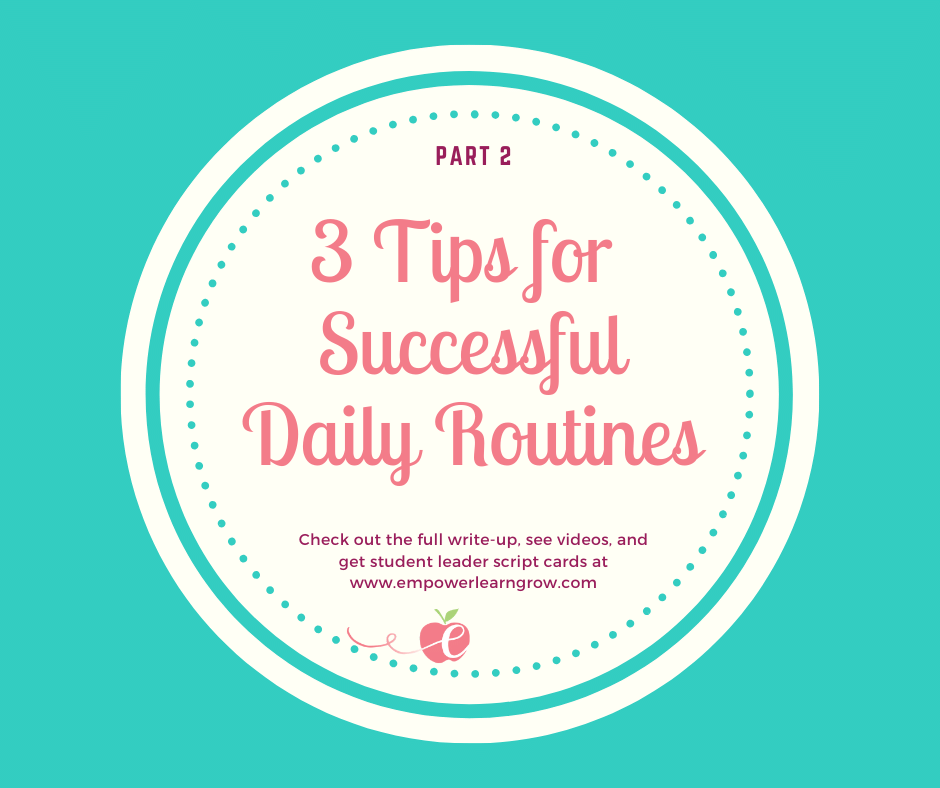
14 Mar Seeing is Believing: 3 Reasons Daily Routines Aren’t Working: Part 2
You want to do the daily routines, you do, I know it. But, you don’t really know how or maybe you don’t really know why. As we add on to last week’s post in our three post series, this post is all about explaining more of the why as well as the start to LOTS of videos to help you believe.
2nd Reason Daily Routines Aren’t Working:
“I don’t get them, therefore I don’t do them or I only do the parts I get.”
Let’s face it. Very few people will do something they don’t understand. As teachers, we know every moment of our instructional time is valuable. If we don’t find value in something, we won’t do it. In addition, we tend to only do or include those components we are confident with ourselves. If we aren’t confident with how to teach something, then we tend to resort to those things we DO understand and are confident in. So, today’s post is to continue to share the importance of doing daily mathematical routines as well as to help you gain CONFIDENCE in doing them so that you are ready and willing to give them a try.
Are you going to be good at them right away? No. Sorry. No sugar coating here. Anything worth doing well takes time! So just be ok with it. Who is an expert the first time? No one! You are probably going to mess the routines up, ask the wrong questions at the wrong time, flip the wrong numbers over, etc. And you know what? It’s going to be ok. You’ll get better.
Will you need to practice them? Yes. You’ll watch and rewatch my videos. You’ll practice with your team. You’ll practice with your students.
Will it all be worth it? YES! 100%.
“ A sense of number is acquired…it is
developed. You don’t teach number
sense, you teach to nurture its
development.”
Skip Fennell
Whether you use the Math Expressions curriculum (grades k-2) or you have a different curriculum, I believe you will find the main components of the routines below as well as my tips, helpful in creating a fluid and valuable daily routine. Enjoy these tips.
- Watch my videos.?
- Be sure to read my first post on this topic to help with the rationale and importance. When we know ‘why’ we are doing the various parts, it is easier to buy in and commit to learning and doing them.
- If you are a Math Expression User, use the Daily Routine videos on the Think Central platform (for 2018 users), but don’t do the finger flashing as they do, it’s not correct! See my video for correct finger flashing. Remember, it’s kinesthetic place value. Tens flash on the left, ones flash on the right.
- Post on our FB Group. Any specific questions or videos not addressed above, I’ll make a video for you! Just mention it on our FB group page.
- Get comfortable with one routine then move onto the next. What is key, however, is that you give yourself set timelines. Otherwise, it might be Spring Break and you are still getting ‘comfy.’ If it’s Spring, you’re TOO comfy— you know what I mean. Comfy is easy. ? Challenge, though, creates change! If you want to change and want your leaders to be proficient, then challenge yourself. You can do it! Of course this is assuming you’ve been doing the routines since the beginning of the year. If you are just starting now, give yourself grace.
- Grab my updated cheat sheet. These help to break down the verbose teacher edition directions into manageable and repeatable steps. Laminate them and keep them where you do the routines. Include them with your sub plans to help your substitute as well. Volume 2 or second half of the year routines and suggestions are coming in the next post.
- Conquer one step at a time. If you need to, just do one part to gain confidence, then add on the additional steps. Just make yourself a timeline to add in the other pieces.
- Say it the same. EVERY TIME. This is where the cheat sheets help. If you practice using the same cues each day, they will become routine. This will make it much easier to pass the routines to student leaders (next week’s post).
- If you don’t have room for all of the components to stay out all day in your classrooms, consider doing them on a virtual platform, smartboard, etc. BUT, keep the 120 (orange) chart visible AT ALL TIMES. This is a counting resource that students should be able to access all day.
Let’s chat about a couple of the important parts of the routines.
Counting each day on the 120 chart and on the flip chart take up precious time. I beg you, don’t give up counting!! Count, count, count. Students should be looking at the charts each day as they count. They need to be seeing number patterns, sequence, etc. Don’t rob students from this necessary experience. Counting impacts all future mathematics. Count while lining up, count while transitioning to the carpet, just count but don’t completely replace the opportunity to see the numbers as you count. All too often I see student leaders pointing to the chart as students count, but very few students are watching and looking at the numbers. Rote counting is one of the first numeracy stages for students. They must know what number to say ‘next’ when adding one, two, ten, etc. This type of counting must be in place!
We are not doing our kids any favors by taking the short cut and removing these valuable experiences. What if we just stopped singing the alphabet because we grew tired of it? Think about the important implications to primary teachers in not only singing the alphabet but by showing the letters as students sing. It is here students tend to first notice that “LMNOP” are five different letters! The visual, auditory connection is one we must not take for granted.
We can insert counting into so many other parts of our day, and if you’ve seen me teach, you know I put it EVERYWHERE, but during the routines, we are able to add the visual component and begin to connect the dots for students who may be rote counting, but who lack the cardinality of ten being the ten boxes, not just the single box labeled ten, or the patterns in the numbers across the chart, etc. Notice! The 120 chart has one box per number. This allows students to count boxes as they count to each new total, whereas a number line is counting lengths. On number lines, students often count the ‘tick’ marks instead of lengths. This, for example, results in getting to the count of four, because there are four tick marks (when starting at zero), instead of 3 for each length. YIKES! Therefore, the National Council of Research doesn’t suggest the use of number lines until 2nd grade when we formally introduce standard measurement. Using the 120 chart as well as the flip chart allows students to see one item per counting number.
Tips for the 120 chart:
- Trim the chart and put into a poster frame. Write on the glass instead of the poster. This will increase the life of your poster.
- Use blue, black or green markers. No red!
- ‘Make a ten’ by drawing a line through your ten circles. To preserve the numbers so students can still see them, draw the ten stick to the right of the numbers in each column instead of through them. Keep the circles, keep the ten stick. This is reinforcing quantity and regrouping.

Framed 120 Chart. Preserve the life of your chart!
The dreaded flip chart.
Of all the routines, this part seems to be the most neglected. I believe it is because it seems repetitive and cumbersome. The flip chart is another way to visualize groups of ten. On the 120 chart, students do this while seeing the actual numbers. On the flip chart, students are more able to visualize the groups of ten and the partners of ten. On this chart, students count by tens instead of ones, identify the partners of ten, and show an additional way to represent the number with an extended equation. In 2nd grade (k& 1 in some states), the money flip chart introduces the concept of money: identifying coins, identifying coin value, adding with coins, and trading in coins for various sums of pennies. Whether you are using the chart with the blue dots or the money, here are some tips to make it an important part of your daily routine.
- Use painter’s tape. Although the teacher edition suggests sticky notes, I can tell you from experience, they don’t work. They fall off and become such a pain! Take a piece of painter’s tape, approximately 2 inches long. Fold it about ¾ of the way back to make a tab. This gives you enough to cover the dot or penny.
- Cover the entire chart at the beginning of the year. This way when you make a new ten and go to the next column, it’s already set up! Your stickies at the bottom just get tossed!
- Remove the cardboard cylinder that is stuck in the wire binding. I know this might sound so unimportant, but I can’t tell you how many charts I go to use and the flips don’t flip because the packaging cardboard cylinder has not been removed! It’s the simple things that can make this part of the routines so much easier.
There are a few other components to the routines that are invaluable. Be sure to check out the tutorial videos to see each of the routines in action. In addition, check out the classroom models of the routines to see them with live students. Please keep in mind that in many of these videos, it is the first-time students have experienced the routines and, therefore, they are not fluent in the responses, participation, etc. that I am expecting and teaching. But they will be!! Everything worth doing takes time and practice. You will notice in the live classroom videos I set up expectations for the participation I want and need, and I hold students accountable to those expectations.
Have a success story? I sooooo want to hear it. We all want to hear them. Let me know any success stories to share with our community. I just had a sweet kinder teacher tell me she finally committed to them and has been so impressed with how much confidence her kinders have gained. Please comment below with your success story and/or any additional questions or comments regarding daily mathematical routines.
Do you feel empowered to give some of these a shot? I hope so. Go BE GREAT. Take your learning and GROW!
Enjoy the videos and the freebies. Subscribe to my YouTube Channel so you don’t miss out on the additional video examples that will be coming soon and only made available to my YouTube Subscribers. Come back next week to get even more live classroom videos, another freebie, and a conclusion to our daily routine series.
Get Your Daily Routine Cheat Sheets Here
Miss Part 1? Get it here along with a rad freebie: https://empowerconsulting.org/3-reasons-your-daily-routines-arent-working-and-what-to-do-about-it-part-1/
Want Part 3 of Daily Routine Hints? Go here: https://empowerconsulting.org/3-reasons-the-daily-routines-arent-working-part-3-i-dont-have-time-and-bonus-content/





Sorry, the comment form is closed at this time.